Wind Energy Explained
In the Flow
In a Flash

Wind energy is a natural resource that can never run out.
People use this wind flow, or motion energy, for many purposes such as sailing and flying a kite. The wind flow, can also be harvested by modern wind turbines and used to generate electricity.
How wind works
Wind is simply air in motion. This motion can be in any direction, but in most cases the horizontal component of wind flow greatly exceeds the flow that occurs vertically.
Wind is caused by differences in atmospheric pressure. Wind speeds vary based on geography, topography and season. Wind is produced by the uneven heating of the Earth's surface by the Sun, variations in the earth's surface, and the earth's rotation.
The Earth's surface is made of land, desert, water, and forest areas which absorb the Sun's radiant energy at different rates. Wind flow patterns are modified by the earth's terrain, bodies of water, and vegetative cover.
Wind is slowed by rough surfaces and obstacles, and flows faster over smooth surfaces.
The Daily Wind Cycle
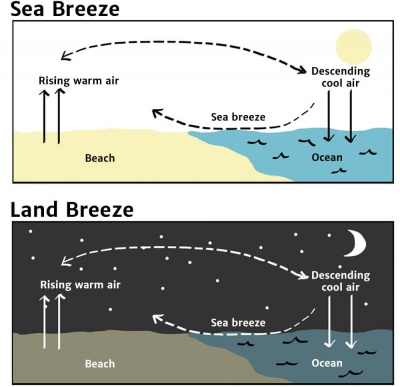
Changing temperatures over land and water makes air move, creating wind.
Wind energy is created by the uneven heating of the Earths' surface by the Sun. During the day, the air above the land heats faster than air over water. This warm air over the land expands and rises, and the cooler air, which is heavier takes its place, creating wind. At night, the winds direction is reversed because the air cools quicker over land than over water. This is called at the Daily Wind Cycle.
In a similar way, the atmospheric winds that circle the earth are created because the land near the Earth's equator is heated more by the Sun than the land near the North and South Poles.
Wind Energy
The terms wind energy or wind power describe the process by which the wind is used to generate mechanical power or electricity.
Wind Energy captures the natural wind in our environment and converts the air's motion into mechanical energy. Wind is caused by differences in atmospheric pressure. Wind speeds vary based on geography, topography and season. As a result, there are some locations better suited for wind energy generation than others. In general, wind speeds are higher near the coast and offshore since there are fewer objects like trees, mountains and buildings to slow them down.
An advantage of wind energy is that it is a clean and renewable form of energy. Its production of electricity has no direct carbon emissions or air pollutants and does not consume water. Wind also has relatively low operations and maintenance costs after initial construction.
However, wind energy also faces several challenges. Wind speeds can vary throughout the day and year, causing inconsistent electricity flow issues for power grids.
The machinery used to convert air motion into electricity is called a turbine. A turbine is a large structure with several spinning blades. These blades are connected to an electro-magnetic generator that generates electricity when the wind causes the blades to spin.
How is Wind Measured?
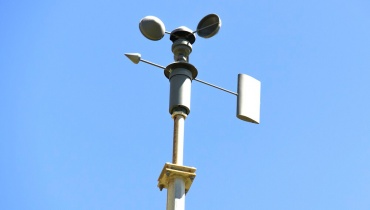
An anemometer measures wind speed.
Wind is the horizontal movement of air and is specified by its speed (velocity) and direction.
Wind speed
Wind Speed is measured in km's or miles per hour using an anemometer. An anemometer looks like a weather vane, but instead of measuring which direction the wind is blowing with pointers, it has four cups so that it can more accurately measure wind speed. Each cup is attached to the end of a horizontal arm, each of which is mounted on a central axis, like spokes on a wheel.
Wind speed generally increases with height above the earth's surface and is affected by variations such as the roughness of the ground and the presence of buildings, vegetation and other obstacles in the area.
Wind direction
Wind Direction is the direction the wind blows from. North, East, South or West. If the wind is coming from a North direction and blowing to the South, the wind is called a Northerly Wind.
Wind is measured in degrees clockwise from due north and so a wind coming from the south has a wind direction of 180 degrees; one from the east is 90 degrees.
Meteorological compass
The meteorological compass uses 360° of angular distance with 0° being a wind from due north. If the wind direction is given in degrees, round this value to the closest cardinal direction given on the compass below.
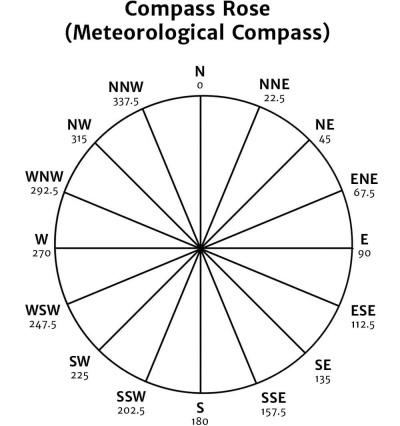
A compass rose helps to tell the direction of the wind more accurately.
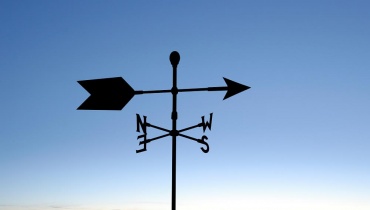
A weather vane shows which direction the wind is blowing.
Weather vane
Another instrument in wind measurement is called a weather vane, consisting of a thin horizontal arm carrying a vertical flat plate at one end with its edge to the wind and at the other end a balance weight which also serves as a pointer. The arm is carried on a vertical spindle mounted on bearings which allow it to turn freely in the wind. When the wind blows, the arm sways until the pointer faces the direction of the wind.
Wind Technologies
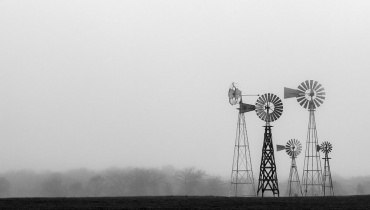
Wind turns the blades of a windmill, which turns the turbine blades to create energy.
How wind works
Wind energy technologies use the energy in wind for practical purposes, such as generating electricity, charging batteries and pumping water. They can be used as stand-alone, connected to a utility power grid, or even combined with a photovoltaic system.
Wind Turbines
The machinery used to convert air motion into electricity is called a turbine. A turbine is a large structure with several spinning blades. These blades are connected to an electro-magnetic generator that generates electricity when the wind causes the blades to spin.
Wind turbines convert the kinetic energy in the wind into electricity. This mechanical power can be used for specific tasks, such as pumping water; or a generator can convert this mechanical energy into electricity to power homes, businesses and schools.
Three key factors affect the amount of energy a turbine can harness from the wind: wind speed, air density and swept area (the area swept by the blades).
Wind turbines generate electricity without producing air pollutants or greenhouse gases. Concerns about the environmental impacts of wind energy center on finding appropriate sites for wind farms.
Wind Farms
Wind Farms, also known as wind energy power stations or wind parks, are made up of hundreds of turbines, spaced out over hundreds of meters. They are constructed in large groups to generate a large quantity of electricity.
Turbines in a wind farm are interconnected through a medium-voltage system. Cables transmit the generated power to a collector substation which is then sent to its destination, usually the power grid.
Wind farms require a lot of land. Each turbine needs space between them. Wind plants need a lot of land. Each turbine requires about 1000 square meters of land and it is recommended each tower be positioned five to ten turbine diameters away from each other, depending on the number of turbines. The land in between the turbines can still be used for agriculture, farming and forestry.
Wind farms are built in areas known to be especially windy on a regular basis. Selecting the location of a wind farm is known as siting a wind farm. To build a wind farm, wind speed and direction must be studied to determine where to put the turbines. The site needs strong, steady winds.
The best locations for wind farms are where the most wind blows. Hilltops, open fields and the coasts of oceans or large lakes are the most common sites chosen.
Turbines are usually built in rows facing into the prevailing wind. Placing turbines too far from each other wastes space. If turbines are too close together they block each other's wind.
Some wind farms are built offshore (in the water) to take advantage of winds that blow across the water. They are built in the shallow waters off the coast, with wind turbines placed on concrete platforms that extend to the bottom of the sea, and further out in the sea using floating platforms.
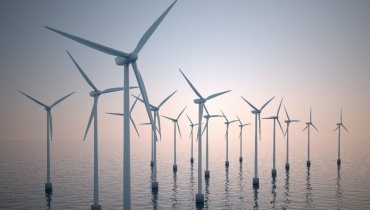
Offshore wind farms capture ocean breezes.
Advantages and Disadvantages of Wind Energy
Benefits of wind energy
- Wind energy is a renewable source of energy. Wind is naturally occurring and there is no way we can empty the energy resources. Wind energy originates from the nuclear fusion processes that take place on the Sun.
- Wind energy is a clean energy source. Once installed, wind energy farms produce no air pollutants or greenhouse gases, so the impact on the environment is only minor compared to other forms of energy production.
- Wind power is inexhaustible. The wind blows day and night, which allows wind turbines to produce electricity throughout both the day and night.
- Up to 95 percent of land used for wind farms can also be used for other profitable activities including agriculture, farming and forestry.
- Wind power does not use water. Producing other power sources such as nuclear, coal, or gas-fired power, uses water for cooling. Water is becoming a scarce resource all over the world. Wind power uses zero water in its energy generation.
Disadvantages of wind energy
- Inconsistent electricity output. The strength of the wind is not constant and it varies from zero to storm force. This means that wind turbines do not produce the same amount of electricity all the time. There will be times when they produce no electricity at all.
- Noise and visual pollution. Concern exists over the sound produced by the turbine blades and their visual impacts to the landscape.
- Wind power does produce pollution. During the manufacturing process of wind turbines, pollution is produced.
- Wind turbines harm wildlife. Bats and birds have been killed by flying into turning turbine blades.
- Installation is expensive. Although costs are reducing over time, the installation of a wind turbine is considered expensive. First, a site survey over a period of time is undertaken, then the manufacturing, delivering and installing of the wind turbine on a pre-built foundation all contributes to the overall cost.
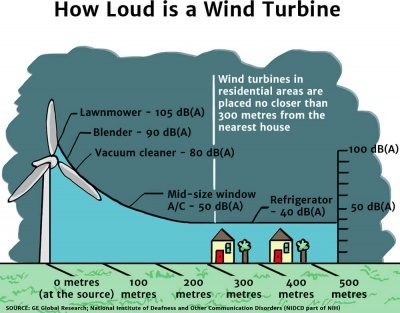
Some people are concerned by the potential noise from wind farms.
Teacher's Toolkit
Take this to the classroom!
Curriculum ready content.
